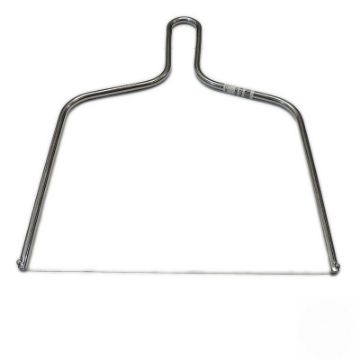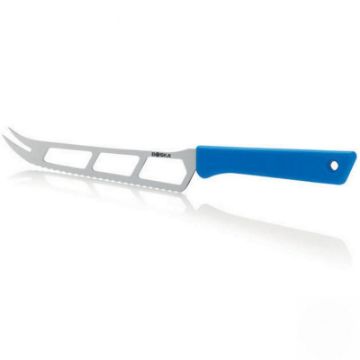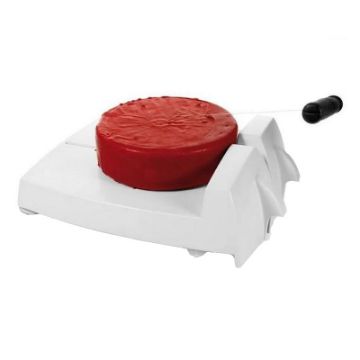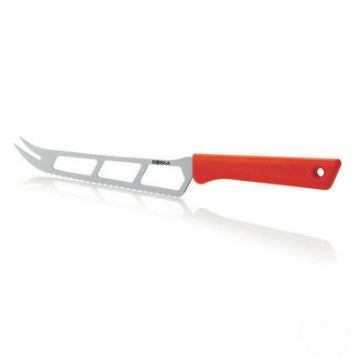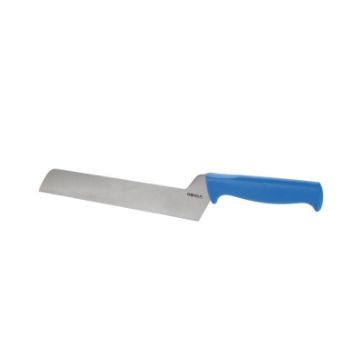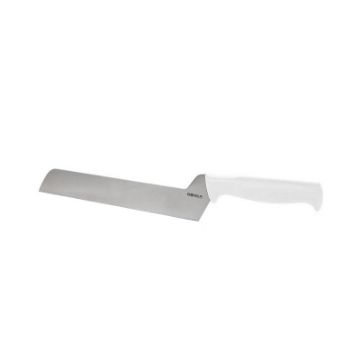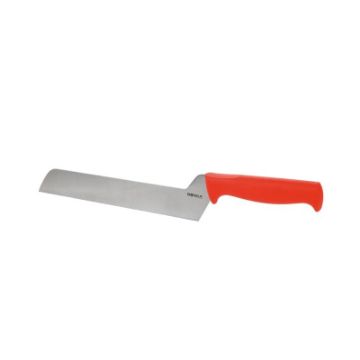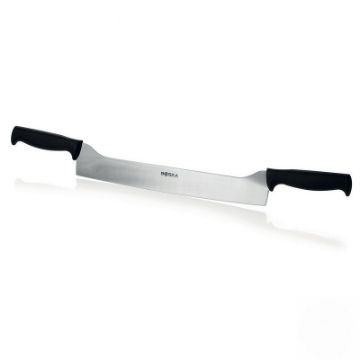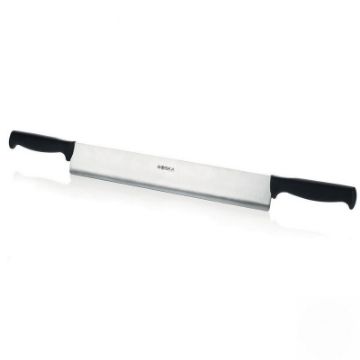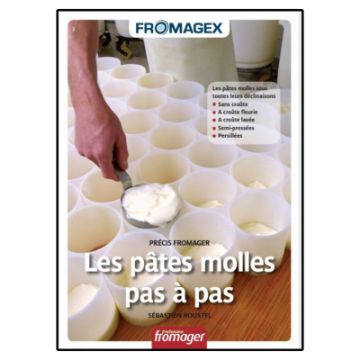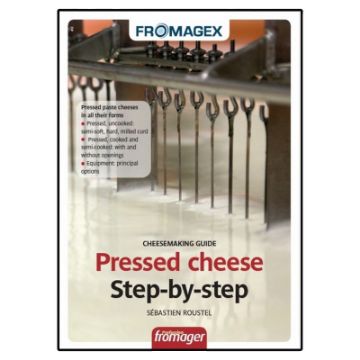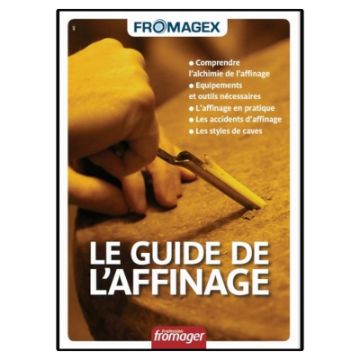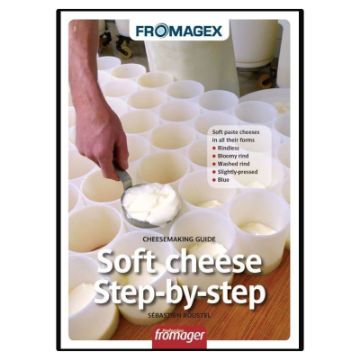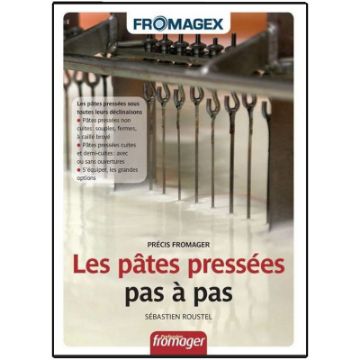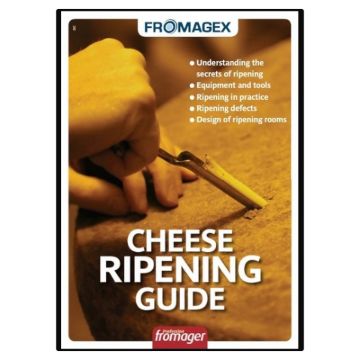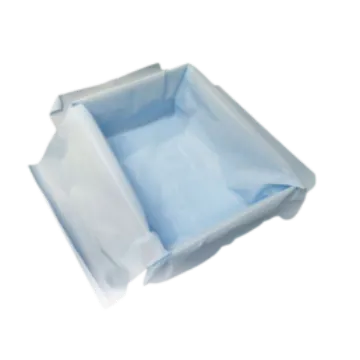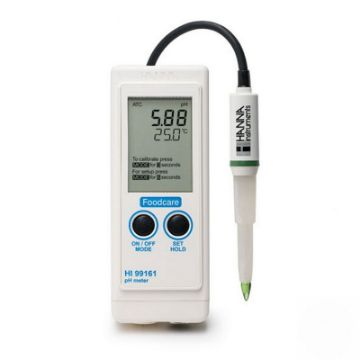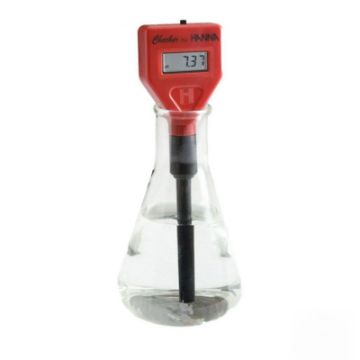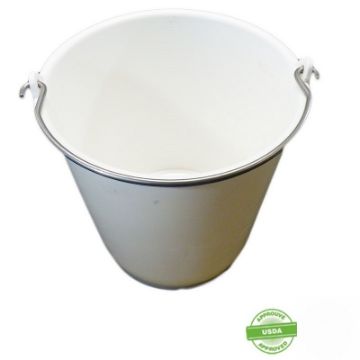Fermier Products
All-purpose knife blue handle 140 mm
HACCP rules state that each type of cheese should be cut with a separate knife.
That is why Boska has developed 3 types of cheese knives with colored handles, in order to avoid cross-contamination.
Complicated?
Of course not:
red is for red bacteria cheeses, white is for white moldy cheeses, and blue is for blue cheese.
Boska also supplies cutting boards in matching colors for each type of cheese.
All-purpose knife The jack-of-all-trades of Boska’s knives.
Thanks to the 3 holes in the blade, cheese does not stick.
The serrated blade is very sharp and even cuts through packaging.
Cheese chopper Pro
The Cheese chopper Pro is the wire cutter for cheese specialists.
This cutter cuts every type of cheese down to size and is especially suited to soft cheeses.
What makes this cutter so exceptional is the special mechanism behind the wire.
It has an improved guidance mechanism, thus reducing the chances of wire breakage and increasing the ease of cutting in one smooth movement.
The ergonomic grip makes the sturdy wire easy to handle, and the wire length is optimized for ease of use.
Boska also devoted extra attention to the replacement of the wire.
If it happens to break, it can be easily replaced by one of the six spare wires included.
Just pop it in – no tools required.
The Cheese chopper Pro is equipped with an anti-slip base, so it won’t drift around on a smooth work surface.
You can choose from two types of feet enclosed in the package:
rubber and suction cups.
The device has a compact shape and the positioning of the feet can be adjusted which allows it to fit on virtually every counter.
The frame is made of super thick plastic, and it has stainless steel wires, making it extremely durable, strong, food-safe, and dishwasher-safe.
In short – it’s super convenient.
Compact wire cutter Suitable for all cheeses New guidance mechanism – less wire breakage and it’s easier to cut Easy wire replacement Includes two types of anti-slip feet Fits on every counter Includes six spare wires Made of super-strong plastic so it’s durable and dishwasher-safe
All-purpose knife white handle 140 mm
HACCP rules state that each type of cheese should be cut with a separate knife.
That is why Boska has developed 3 types of cheese knives with colored handles, in order to avoid cross-contamination.
Complicated?
Of course not:
red is for red bacteria cheeses, white is for white moldy cheeses, and blue is for blue cheese.
Boska also supplies cutting boards in matching colors for each type of cheese.
All-purpose knife The jack-of-all-trades of Boska’s knives.
Thanks to the 3 holes in the blade, cheese does not stick.
The serrated blade is very sharp and even cuts through packaging.
All-purpose knife red handle 140 mm
HACCP rules state that each type of cheese should be cut with a separate knife.
That is why Boska has developed 3 types of cheese knives with colored handles, in order to avoid cross-contamination.
Complicated?
Of course not:
red is for red bacteria cheeses, white is for white moldy cheeses, and blue is for blue cheese.
Boska also supplies cutting boards in matching colors for each type of cheese.
All-purpose knife The jack-of-all-trades of Boska’s knives.
Thanks to the 3 holes in the blade, cheese does not stick.
The serrated blade is very sharp and even cuts through packaging.
Knife for semi-hard cheese blue handle 210 mm
HACCP rules state that each type of cheese should be cut with a separate knife.
That is why Boska has developed 3 types of cheese knives with colored handles, in order to avoid cross-contamination.
Complicated?
Of course not:
red is for red bacteria cheeses, white is for white moldy cheeses, and blue is for blue cheese.
Boska also supplies cutting boards in matching colors for each type of cheese.
This knife has a raised handle so that your cutting hand stays clear of the cutting board.
It is also suitable for larger cheeses like Brie and Raclette.
Knife for semi-hard cheese white handle 210 mm
HACCP rules state that each type of cheese should be cut with a separate knife.
That is why Boska has developed 3 types of cheese knives with colored handles, in order to avoid cross-contamination.
Complicated?
Of course not:
red is for red bacteria cheeses, white is for white moldy cheeses, and blue is for blue cheese.
Boska also supplies cutting boards in matching colors for each type of cheese.
This knife has a raised handle so that your cutting hand stays clear of the cutting board.
It is also suitable for larger cheeses like Brie and Raclette.
Knife for semi-hard cheese red handle 210 mm
One of the must-haves for every cheese department!
This tools is the necessary basics when cutting regular cheeses in a professional way.
A good set of cheese tools is half the battle.
HACCP rules state that each type of cheese should be cut with a separate knife.
That is why Boska has developed 3 types of cheese knives with colored handles, in order to avoid cross-contamination.
Complicated?
Of course not:
red is for red bacteria cheeses, white is for white moldy cheeses, and blue is for blue cheese.
Boska also supplies cutting boards in matching colors for each type of cheese.
This knife has a raised handle so that your cutting hand stays clear of the cutting board.
It is also suitable for larger cheeses like Brie and Raclette.
Les pâtes molles pas à pas
They often learn ‘on the job’.
This guide offers, in a precise, detailed, and accessible manner, step-by-step instructions for the main types of cheese that fall within this category.
Cheese technologist and educator with expertise in both the artisanal and industrial sectors, the author offers his understanding of the principles and his practical knowledge to the reader, taking care to offer detailed information about equipment, tools, and other requirements for successful cheesemaking.
He also lays out, step-by-step, optional adaptations to the cheesemaking process.
Author:
Sébastien Roustel is a cheesemaking technologist.
Pressed cheese step-by-step
This practical guide offers, in very concrete terms, recipes for a dozen iconic cheeses from this large family:
Tomme grise, Trappist, Raclette, Cheddar, Gruyère style…Cheesemaking technologist and instructor by profession, equally expert in the artisanal and industrial arenas, the author describes the precise steps to follow for each style, with adaptations and options throughout the process, including how to resolve occasional problems, while also including different configurations possible for equipment and tools.
Author:
Sébastien Roustel is a cheese technology expert at CHR-Hansen.
Prior to this he directed the research and development service at the Enilbio at Poligny.
He also wrote the guide “Soft Paste Cheese, Step-by-Step”, published in this same collection.
Le guide de l'affinage
- How to bring a soft curd with a bloomy mold rind to its optimum taste?
- How to get a creamy layer under the rind?
- When is it more appropriate to use static or ventilated refrigeration?
- How to inoculate a ripening cellar?
- How to make a smear?
One of a kind, sometimes reference technical work and sometimes field work, this guide provides concrete and pragmatic answers for all the big cheese families.
Written in simple language and accessible, it thus alternates general scientific knowledge, practical tips, implementation diagrams, testimonials from professionals, diagnostics and defect resolution sheets.
To those who want to embark on ripening, it will give the keys to understanding and reaction.
To those who already practice this art where the sense of the observation is preponderant, it will bring new insights and will allow them to perfect their practice.
Authors:
Arnaud Sperat-Czar is the publisher and editor-in-chief of the magazine « Profession Fromager ».
Sébastien Roustel, technologist and trainer, is in charge of development of cheese technology at CHR-Hansen.
He was previously the head of the Research and Development Department of Enilbio in Poligny.
Débora Pereira is a journalist, a researcher in information sciences and collaborator of « Profession Fromager».
She runs the association «Sertaobras», which works to promote the Brazilian cheese heritage.
The book benefited from the advice and careful reading of Bernard Mietton, renowned French technologist.
Soft cheese step-by-step
They often learn ‘on the job’.
This guide offers, in a precise, detailed, and accessible manner, step-by-step instructions for the main types of cheese that fall within this category.
Cheese technologist and educator with expertise in both the artisanal and industrial sectors, the author offers his understanding of the principles and his practical knowledge to the reader, taking care to offer detailed information about equipment, tools, and other requirements for successful cheesemaking.
He also lays out, step-by-step, optional adaptations to the cheesemaking process.
Author:
Sébastien Roustel is a cheesemaking technologist.
Les pâtes pressées pas à pas
This practical guide offers, in very concrete terms, recipes for a dozen iconic cheeses from this large family:
Tomme grise, Trappist, Raclette, Cheddar, Gruyère style…Cheesemaking technologist and instructor by profession, equally expert in the artisanal and industrial arenas, the author describes the precise steps to follow for each style, with adaptations and options throughout the process, including how to resolve occasional problems, while also including different configurations possible for equipment and tools.
Author:
Sébastien Roustel is a cheese technology expert at CHR-Hansen.
Prior to this he directed the research and development service at the Enilbio at Poligny.
He also wrote the guide “Soft Paste Cheese, Step-by-Step”, published in this same collection.
Cheese ripening guide
- How to bring a soft curd with a bloomy mold rind to its optimum taste?
- How to get a creamy layer under the rind?
- When is it more appropriate to use static or ventilated refrigeration?
- How to inoculate a ripening cellar?
- How to make a smear?
One of a kind, sometimes reference technical work and sometimes field work, this guide provides concrete and pragmatic answers for all the big cheese families.
Written in simple language and accessible, it thus alternates general scientific knowledge, practical tips, implementation diagrams, testimonials from professionals, diagnostics and defect resolution sheets.
To those who want to embark on ripening, it will give the keys to understanding and reaction.
To those who already practice this art where the sense of the observation is preponderant, it will bring new insights and will allow them to perfect their practice.
Authors:
Arnaud Sperat-Czar is the publisher and editor-in-chief of the magazine « Profession Fromager ».
Sébastien Roustel, technologist and trainer, is in charge of development of cheese technology at CHR-Hansen.
He was previously the head of the Research and Development Department of Enilbio in Poligny.
Débora Pereira is a journalist, a researcher in information sciences and collaborator of « Profession Fromager».
She runs the association «Sertaobras», which works to promote the Brazilian cheese heritage.
The book benefited from the advice and careful reading of Bernard Mietton, renowned French technologist.



